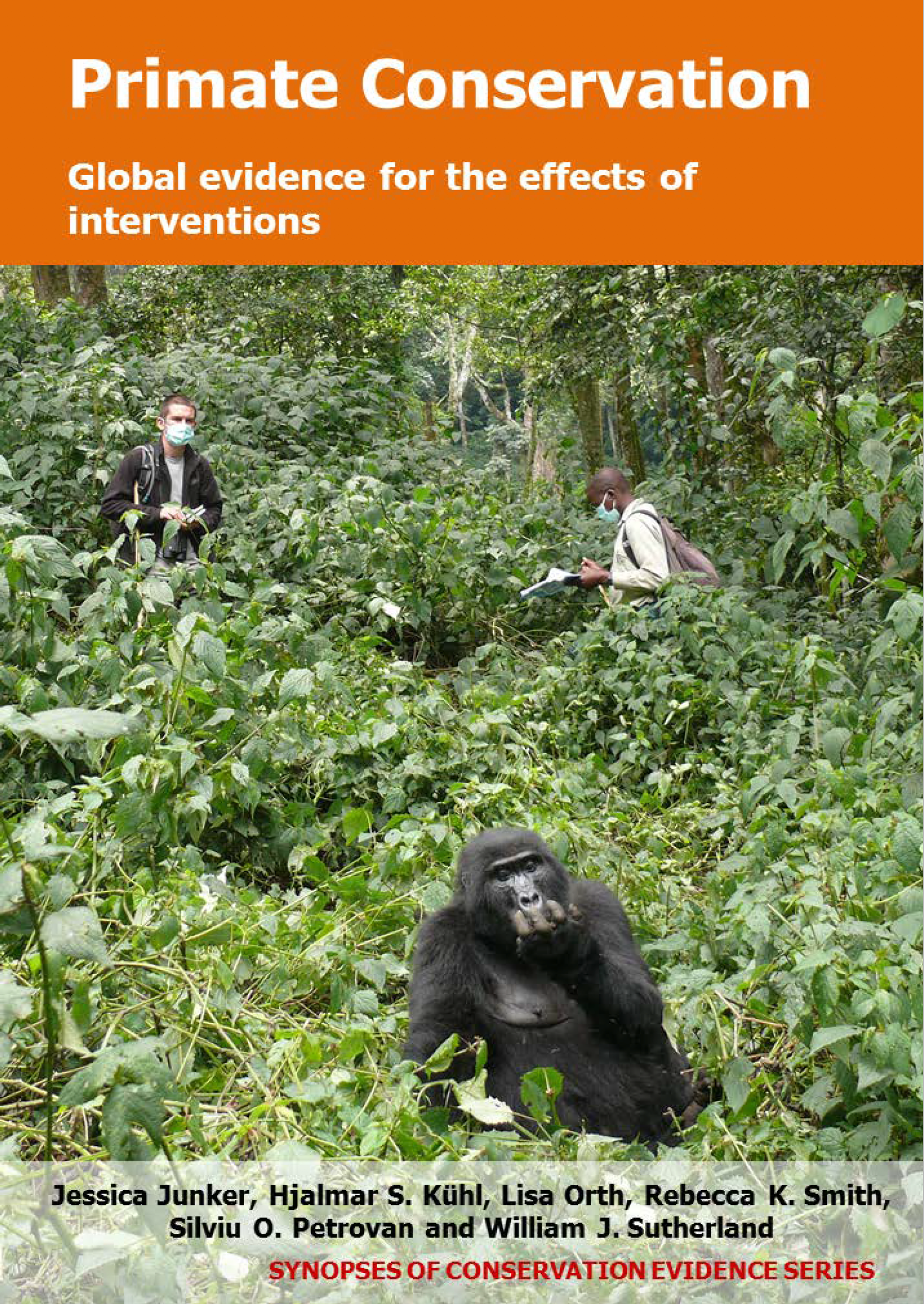Actions to conserve biodiversity
We have summarised evidence from the scientific literature about the effects of actions to conserve wildlife and ecosystems.
Review the evidence from the studies
Not sure what Actions are? Read a brief description.
Search for evidence
e.g. "frogs chytrid"
162 Actions found
Refine
Hide
162 Actions found
Download Actions
| 0 selected |
|
Order results by:
| Action | Effectiveness | Studies | Category | |
|---|---|---|---|---|
|
Work inward from barriers or boundaries (e.g. river) to avoid pushing primates toward an impassable barrier or inhospitable habitat Action Link |
No evidence found (no assessment) | 0 |
|
|
|
Wear gloves when handling primate food, tool items, etc. Action Link |
No evidence found (no assessment) | 0 |
|
|
|
Wear face-masks to avoid transmission of viral and bacterial diseases to primates Action Link |
Unknown effectiveness (limited evidence) | 2 |
|
|
|
Use weeding to promote regeneration of indigenous tree communities Action Link |
No evidence found (no assessment) | 0 |
|
|
|
Use shelter wood cutting instead of clear-cutting Action Link |
No evidence found (no assessment) | 0 |
|
|
|
Use selective logging instead of clear-cutting Action Link |
Unknown effectiveness (limited evidence) | 3 |
|
|
|
Use prescribed burning within the context of home range size and use Action Link |
No evidence found (no assessment) | 0 |
|
|
|
Use patch retention harvesting instead of clear-cutting Action Link |
No evidence found (no assessment) | 0 |
|
|
|
Use of unpalatable buffer crops Action Link |
No evidence found (no assessment) | 0 |
|
|
|
Use of natural hedges to deter primates Action Link |
No evidence found (no assessment) | 0 |
|
|
|
Use nets to keep primates out of fruit trees Action Link |
Unknown effectiveness (limited evidence) | 1 |
|
|
|
Use loud-speakers to broadcast sounds of potential threats (e.g. barking dogs, explosions, gunshots) Action Link |
No evidence found (no assessment) | 0 |
|
|
|
Use loud-speakers to broadcast primate alarm calls Action Link |
No evidence found (no assessment) | 0 |
|
|
|
Use GPS and/or VHF tracking devices on individuals of problem troops to provide farmers with early warning of crop raiding Action Link |
No evidence found (no assessment) | 0 |
|
|
|
Use fences as biological corridors for primates Action Link |
No evidence found (no assessment) | 0 |
|
|
|
Use 'set-asides' for primate protection within logging area Action Link |
No evidence found (no assessment) | 0 |
|
|
|
Use 'set-aside' areas of natural habitat for primate protection within mining area Action Link |
No evidence found (no assessment) | 0 |
|
|
|
Treat sick/injured animals Action Link |
Unknown effectiveness (limited evidence) | 18 |
|
|
|
Translocate (capture & release) wild primates from development sites to natural habitat elsewhere Action Link |
Unknown effectiveness (limited evidence) | 6 |
|
|
|
Translocate (capture & release) wild primates from abundant population areas to non-inhabited environments Action Link |
Unknown effectiveness (limited evidence) | 1 |
|
|
|
Train langur monkeys to deter rhesus macaques Action Link |
No evidence found (no assessment) | 0 |
|
|
|
Thin trees within forests Action Link |
No evidence found (no assessment) | 0 |
|
|
|
Strengthen/support/re-install traditions/taboos that forbid the killing of primates Action Link |
Unknown effectiveness (limited evidence) | 1 |
|
|
|
Strategically lay out the scent of a primate predator (e.g. leopard, lion) Action Link |
No evidence found (no assessment) | 0 |
|
|
|
Run tourist projects and ensure permanent human presence at site Action Link |
Trade-off between benefit and harms | 8 |
|
Download Actions
| 0 selected |
|

Primate Conservation - Published 2017
Primate Synopsis
Watch this search
If you are familiar with RSS feeds, please click the button below to retrieve the feed URL:
RSS feed for this searchIf you are unfamiliar with RSS feeds, we would suggest reading this BBC article.
Unfortunately, due to the number of feeds we have available, we cannot provide e-mail updates. However, you could use tools such as Feed My Inbox to do this for you.
What are 'Individual studies' and 'Actions'?
Individual studies
An individual study is a summary of a specific scientific study, usually taken from a scientific journal, but also from other resources such as reports. It tells you the background context, the action(s) taken and their consequences.
If you want more detail please look at the original reference.
Actions
Each action page focuses on a particular action you could take to benefit wildlife or ecosystems.
It contains brief (150-200 word) descriptions of relevant studies (context, action(s) taken and their consequences) and one or more key messages.
Key messages show the extent and main conclusions of the available evidence. Using links within key messages, you can look at the paragraphs describing each study to get more detail. Each paragraph allows you to assess the quality of the evidence and how relevant it is to your situation.
Where we found no evidence, we have been unable to assess whether or not an intervention is effective or has any harmful impacts.





)_2023.JPG)














